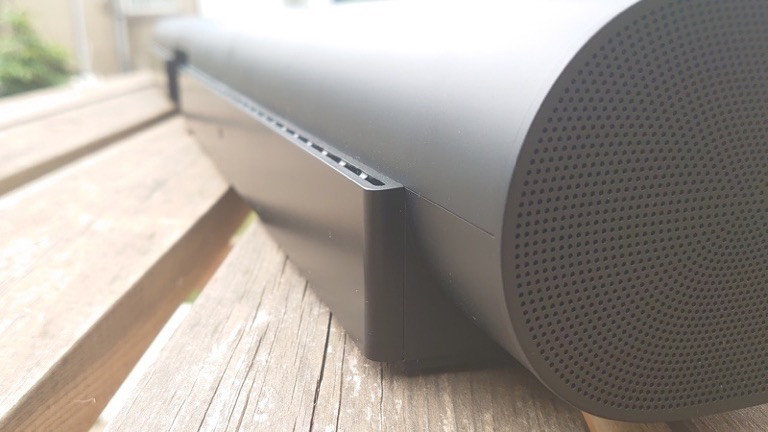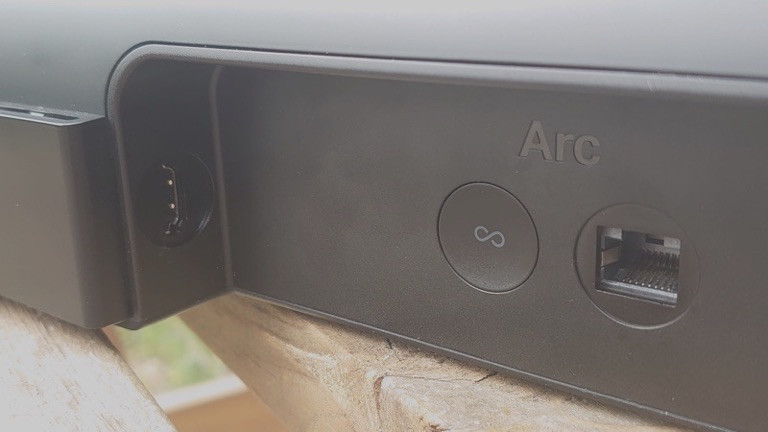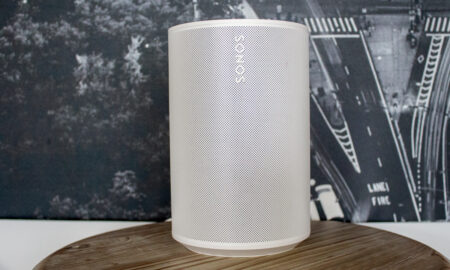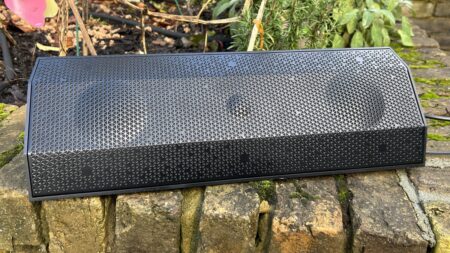Sonos' latest flagship TV room is a top-end home cinema addition
If you want to get a decent impression of home cinema sound without the upheaval a more usual surround-sound system can cause, and especially if you’ve some Sonos equipment already, the Arc is a very welcome addition to the Sonos portfolio. It’s by no means your only choice where Dolby Atmos soundbars are concerned, but thanks to its build quality, its ease of use and, most of all, its audio potency, in the Arc, Sonos finally has a real contender.
Pros
- Simple and slick to set up and use
- Expansive Dolby Atmos sound
- Numerous streaming options
- Class-leading app
Cons
- Not cheap
- Can get aggressive at the top end
- Some very capable competition
- You might need a new TV
As far as refreshing its model line-up goes, Sonos doesn’t seem to be in that much of a rush. Its Playbar soundbar, for instance, soldiered on in increasing irrelevance for seven years – but now it is consigned to that brief list titled ‘Sonos Products That Weren’t Really Much Cop’.
It’s now replaced by a much more pertinent product: the Sonos Arc (the much loved Sonos Beam soundbar is a much more entry-level proposition).
Guide: The best Alexa soundbars
Arc is a Dolby Atmos-enabled soundbar, designed to bring a taste of object-based home cinema surround-sound without the need for multiple speakers in multiple parts of your room. It’s also intended to function as a wireless music system, and/or as part of a true surround-sound set-up (with the likes of Sonos Ones as rear speakers and perhaps a Sonos Sub for the bass-crazed), and/or as part of a wider Sonos multiroom set-up.
In short, then, Arc is meant to do it all – and, ideally, in some style. But does it?

Sonos Arc: Design and hardware
Thanks to its smooth matte-black or matte-white finish, plus those small circular acoustic perforations running along its length, Arc looks exactly like you’d expect a Sonos speaker to look.
At 9 x 115 x 12cm, though, it’s obviously quite a bit bigger than the Sonos norm – and unless it’s beneath a TV of at least 55 inches, it’s going to look a bit ill-proportioned. The base is gently rubberised, for positioning on a surface, and there are screw holes at the rear for wall-mounting.
A bespoke wall-bracket will be available ‘soon’, according to Sonos and, if you choose to wall-mount then the speaker itself will know it’s been fixed on a wall and will adjust its settings automatically, so as not to overload you with extra bass.
Soundbar showdown: Sonos Beam vs Sonos Arc
A recess at the back of the bar contains Arc’s few physical connections: a socket for mains power, an Ethernet input, an HDMI eARC socket and a set-up button.
On the top surface there are a few capacitive controls covering play/pause, volume up/down and skip forwards/backwards, plus four far-field mics for use with voice control.
The much-discussed S2 version of the Sonos control app made its first appearance at pretty much the same time as the Arc. It’s as easy to integrate Google Assistant or Amazon Alexa voice control into the app as it is your favorite streaming services (and Sonos offers you literally hundreds to choose from), and the brilliantly worthwhile Sonos Radio is included from the off.
The way S2 ignores some legacy Sonos equipment has been controversial, but the app itself remains a model of logic and stability – the list of companies that couldn’t learn a thing or two about control apps from Sonos is very short indeed.
Verdict: Sonos Beam 2 review
Sound is delivered by an 11-strong array of speaker drivers, each powered by its own discrete block of Class D amplification. As is the norm, Sonos doesn’t want to give too much away – so there’s no power rating quoted, and the size and composition of the Arc’s eight elliptical mid/bass drivers is secret information too.
There’s a mid/bass driver at each end of the Arc (to provide sonic width), a couple facing upwards from the top (which reflect sound from the ceiling to deliver the impression of height), and the other four are positioned at strategic angles across the front. These last four are punctuated by three silk-dome tweeters.

Sonos Arc: Setup and wireless options
Arc is as easy to set up as any other Sonos speaker. The app invites you to either set up a new system or join an existing Sonos arrangement, and then uses Bluetooth to establish a connection with the Arc. After that it’s simplicity itself to get the Arc onto your home network, and link it to any other Sonos equipment you may have about the place. And if you’ve an iOS device, you can use Sonos’ Trueplay feature to allow the Arc to tune itself to its specific surroundings.
This level of simplicity and common sense as far as set-up and functionality are concerned shouldn’t be understated. It’s a reasonably big part of what put Sonos in its preeminent position in the first place.
Having used Bluetooth for initial set-up, though, Sonos then goes on to ignore it completely when it comes to wireless connectivity to the Arc. Beyond the local network, you’re looking at Apple AirPlay 2 for wireless operation – plus, of course, the particular streaming service(s) you’ve integrated into the S2 app.
Sonos Arc: Voice control and multiroom
The last place you should position your new Arc is within a shelf (or some other surface) directly above it. Not only will this ruin the chances of it creating any Dolby Atmos-style impression of height to the sound, it also makes it tricky for the soundbar’s far-field mics to pick up your voice commands.
Guide: Sonos speakers and Amazon Music HD
Keep the top of the Arc free from obstruction, though, and it proves sharp-eared and responsive. There is no EQ adjustment available (beyond the automated Trueplay facility) and as a consequence you’ll most likely restrict your commands to the obvious one for playback control. In that respect, the Arc works perfectly well.
The app makes incorporating the Arc into an existing Sonos multiroom system straightforward, too. And if you hanker after the whole surround-sound experience, designating the Arc as the front left/right/centre channels of a system with Sonos speakers as the rear channel is simple, too.

Sonos Arc: Sound quality
Given the best chance to shine, using a modern TV with an eARC HDMI port, with the Dolby Atmos-soundtracked Da 5 Bloods via Netflix, the Sonos Arc doesn’t take long to establish its credentials. Fundamentally, it’s a big, bold performer that’s capable of generating a soundstage considerably larger than its physical dimensions.
If you’ve an iOS device, and if you’ve let Trueplay do its thing (and if your listening room isn’t really big, with very high ceilings), the Arc is capable of including authentic width and height to its delivery. Effects that would be in the rear channels of a ‘traditional’ surround-sound set-up might almost be originating from alongside your seated position – or, at least, approaching alongside. And the height effects that in a regular Dolby Atmos set-up would come from speakers integrated into the ceiling seem to derive from a point way above the Arc itself.
No, the Sonos can’t quite fool you into thinking sound is coming from above you, or behind you. But the point-source of the sound it’s delivering isn’t fixed to the soundbar, and as a consequence the sonic impression is expansive and quite enveloping.
Of course, if you decide to strap on a couple of Sonos One SLs for use as rear channels you’ll get a much more convincing impression of surround-sound – and the Arc’s digital sound processing algorithms will take a lot of the rear-channel information away from the soundbar, leaving it free to concentrate on acting as the front three channels. That same DSP switches a lot of the bass information away from Arc should you decide to incorporate a Sonos Sub, too.
Tonally the Arc is pretty clean – there’s some latent treble aggravation waiting to surprise those who really push the volume up towards maximum, and when all the frequency information is being directed through the Arc there can sometimes be a slight disconnect between bass information and the midrange frequencies above it. But in terms of coherence, detail retrieval and straightforward fidelity, the Sonos Arc does impressive work.
Switching to some music (doesn’t matter if it’s stereo stuff or some of TIDAL’s recent rash of Dolby Atmos music mixes) and these little foibles are a little more pronounced. But where drive and attack, dynamism, detail levels, timing and integration are concerned, there’s really very little to complain about here. Obviously a pair of stereo speakers will give you a more assured description of music, but a pair of stereo speakers aren’t about to fool you into thinking movie sound-effects are coming from above you.
If you want to get a decent impression of home cinema sound without the upheaval a more usual surround-sound system can cause, and especially if you’ve some Sonos equipment already, the Arc is a very welcome addition to the Sonos portfolio. It’s by no means your only choice where Dolby Atmos soundbars are concerned, but at least Sonos finally has a contender.

Sonos Arc: eARC and Dolby Atmos
To be clear, you will need to have a TV boasting the latest eARC technology to get an undiluted, lossless, Dolby Atmos experience. TVs with HDMI ARC ports may have had firmware updates to make this possible too – but the general rule is that, if it’s not eARC, you’ll probably get a compressed version of Atmos.
That’s not a bad thing though and certainly not a deal-breaker as you’ll still get excellent multichannel surround sound and most Atmos sources – think Apple TV, Fire TV, Netflix and the gang – are serving compressed Atmos anyway. It’s only really 4K Blu-Rays at this point serving up the ‘real’ Atmos.
You can, if you wish (you shouldn’t wish) also use an optical cable with the Arc too, but you’d be foregoing any sense of Atmos with this option. As well as Atmos, Arc can also play PCM stereo, Dolby Digital 5.1, Dolby Digital Plus.






